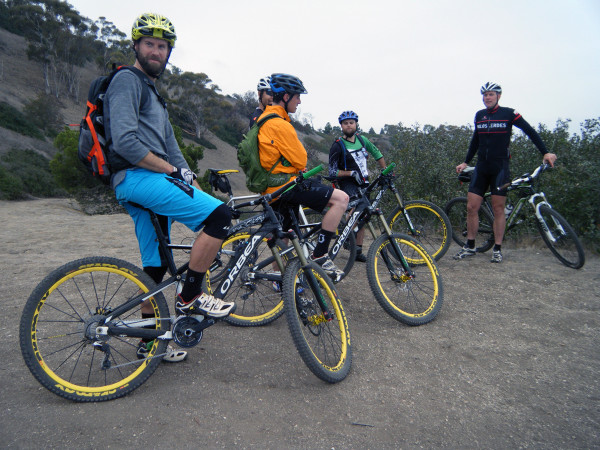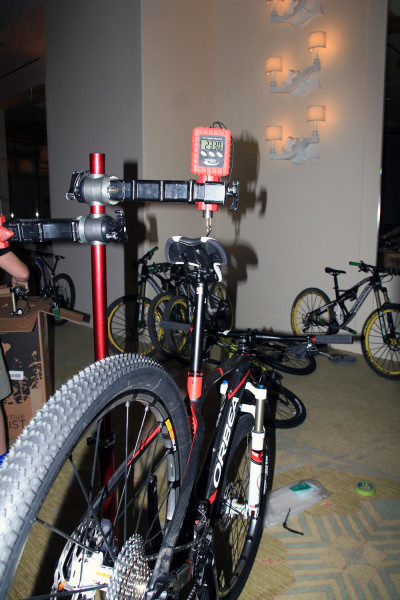The chance to ride a new bike is always a fun opportunity. When that chance comes in dusty, 70° SoCal conditions when it was below zero back home, it doesn’t really matter what you ride because you’re gonna have a good time. However, when I found out that Orbea was going to have the new Rallon R4 on hand at Press Camp, I knew immediately what bike I would be grabbing as we set off for the hills around LA.
Having spent a good amount of time on the Rallon R3, a bike that I liked quite a bit, the new Enduro focused R4 has been on my mind since it was recently introduced. The new bike is longer, lower, slacker, lighter, and has longer legs than its predecessor. How is it on the trails? Check out the two(!) ride review after the break as well as some actual weights for both the 2014 Rallon and Alma 27.5/29er!

The riding along the ocean in LA certainly isn’t very technical. Scenic yes, difficult no. Fortunately this was simply linking up dirt trails to make it to a fun little spiderweb of trails that led to a decent downhill called Dave’s Trail which was probably the most technical riding we experienced on either ride. Nothing crazy, but good enough to get a quick feel for the bike. Anyone who’s ridden in the area knows how punchy and steep the climbs can be – the first ride was about 10 miles with 2000 feet of climbing. While the Rallon is clearly meant to go downhill, it is surprisingly adept at climbing, at least at the back of the bike.
Always efficient while climbing for such a big bike, the front end wanted to wander when things got steep likely due to the longer travel fork and slack 66° head tube angle. This setup makes the bike rip downhill sections, and offers a low center of gravity with a 21mm lower BB than the Rallon R3 – something I found out when I caught a pedal on a root while charging Dave’s Trail. Fortunately, the Rallon is equipped with adjustable geometry through a eccentric shock mount pin which drops or raises the BB by 7mm and slackens or steepens the head tube angle by 0.5°. I’m looking forward to getting a Rallon R4 in for review to try out the other suspension setting to see what it does for steep climbing.
With that said, even with the front end wanting to find its own way when climbing, the R4 climbs way better than you’d think a 30 pound, 160mm travel bike should. It probably won’t win you many KOMs going uphill but it will get you there quickly so you can focus on what you really want to do – descend. Conditions were super loose thanks to a dry SoCal winter, but when there was traction to be had the rear end of the bike tracked nice and straight through washboard and off camber sections, slashing easily around tight switchbacks. Even with minimal suspension tuning and set up of the BOS suspension the Rallon was easy to jump on and ride hard.
Compared to the Rallon R3, the R4 is certainly a longer, slacker, bigger animal all together but still seems to have the super composed nature that made the R3 so good. The wheel size change does make for a longer wheel base and a 25mm longer reach, which for me meant switching from a medium R3 to a small R4 – the change was easy to see by checking out the geometry numbers. With the redesign of the Rallon, Orbea looked to create a purpose built enduro racer that could tackle the toughest downhills – by first impressions they seem to have nailed it.
Press Camp schedule was pretty tight so you’ll have to excuse the photos of the actual bike weights since Orbea was nice enough to stop boxing the bikes for me to weigh them. A medium Rallon X-team which was the build I was riding, checked in at 30.03 lbs. The SLX/Deore and Fox equipped X30 just about 2.5 lbs heavier at 32.50lbs. Unfortunately the Rallon X-team was already in the box and I wasn’t about to make them unbox it, but with a SRAM XX1 drivetrain and carbon Roam wheels you can bet that it is under 30 lbs. Carbon frames would drop some weight from the new Rallon, but for Orbea durability was important, and even with the longer travel suspension the R4 frame is 300g lighter than the R3. So don’t expect any carbon. Yet.
In addition to the Rallons, Orbea also had the new Almas on hand that Tyler scoped out at Eurobike. First introduced in 2006, the Alma has gone through a number of changes, and wheel sizes, to now be offered in 27.5″ for small and medium frames, and 29″ for Medium, large, and extra large. We’ve seen a few other companies like Yeti get in on this two-wheel-size-one-platform sizing system, but Orbea seems to take it a step further by offering a medium in both sizes.
The new Alma was designed to be lighter, more comfortable, have better stack and reach allowing for lower bar positions along with a host of other improvements like new cable routing that is electronic compatible (hmm). Other changes include going to a 27.2 seatpost, BB92 instead of PF30, and 423mm chainstays for the 27.5″ bike and 436mm for the 29″ bike. On the scale, the Alma M Team 29″ was surprisingly little different from the Alma M Team 27.5″ at 21.76 and 21.65lbs. While it was painted like the M10, the blue and white bike was built like the M LTD with a SRAM XX1 build and some light parts for a 20.37lb weight. Finally, the XT equipped M20 was looking good at 23.30lbs, but it was running lighter Mavic wheels.
Thanks to a small glitch in the machine, we lost a bunch of posts and all the comments associated with them in the past day and a half. We have worked hard to restore all that we could, but if you comment is not showing, please note that it is likely due to the website error. We apologize for the inconvenience.








